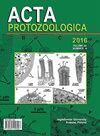入侵种日本结缕草(Fallopia japonica)土壤系统中冬季裸变形虫的丰度与邻近站点的比较
IF 1.5
4区 生物学
Q4 MICROBIOLOGY
引用次数: 6
摘要
在威胁北美和欧洲生态系统生态平衡的入侵植物中,日本结叶草(Fallopia japonica)数量最多。为了确定原生生物在结缕草入侵能力中的潜在作用,对3个结缕草路边灌丛土壤中裸变形虫的冬季丰度与附近未入侵地进行了比较。日本结叶土壤中变形虫的丰度(t = 5.43, df, 16, p < 0.001)高于对照地。这是第一次有研究证明土壤中裸露的阿米巴虫的丰度与入侵植物有关,这可能更普遍地表明,地下丰富的阿米巴虫可以促进土壤肥力,支持一些入侵植物物种的成功适应和扩张。此外,对冬季土壤中被包裹的变形虫和营养形式的裸变形虫的分析,提供了自然环境中土壤样品中具有抗冻性的变形虫静止细胞的证据,支持了先前仅基于实验室实验证据的发现。总体而言,在日本结叶植物的冬季土壤中,有大量的裸变形虫,其中一些是能够形成快速激活营养阶段的休眠细胞,可能增加了土壤肥力,增强了物种的入侵能力。本文章由计算机程序翻译,如有差异,请以英文原文为准。
Winter abundances of naked amoebae in the soil system of the invasive species Japanese knotweed (Fallopia japonica) with comparative data from adjacent sites
Among the most prolific invasive plant species posing threats to the ecological balance of ecosystems in North America and Europe is Japanese knotweed (Fallopia japonica). In order to identify the potential role of protists in the invasive capacity of Japanese knotweed the winter abundances of naked amoebae in soils from three roadside thickets of Japanese knotweed were compared to nearby non-invaded sites. Japanese knotweed soils had higher abundances (t = 5.43, df, 16, p < 0.001) of amoebae than comparison sites. This is one of the first studies to document higher abundances of soil naked amoebae associated with an invasive plant, and may indicate more generally that below-ground abundances of amoebae can promote soil fertility and support the successful adaptation and expansion of some invasive plant species. Moreover, analysis of encysted vs. trophic forms of naked amoebae in the winter soil, provided evidence of freezeresistant, amoeba resting cells in soil samples from the natural environment in support of prior findings that were based solely on laboratory experimental evidence. Overall, high densities of naked amoebae in the winter soils of Japanese knotweed, some as resting cells capable of forming rapidly activated trophic stages, likely increase soil fertility and strengthen the species’ invasive capacity.
求助全文
通过发布文献求助,成功后即可免费获取论文全文。
去求助
来源期刊

Acta Protozoologica
生物-微生物学
CiteScore
2.00
自引率
0.00%
发文量
8
审稿时长
>12 weeks
期刊介绍:
Acta Protozoologica - International Journal on Protistology - is a quarterly journal that publishes current and comprehensive, experimental, and theoretical contributions across the breadth of protistology, and cell biology of Eukaryote microorganisms including: behaviour, biochemistry and molecular biology, development, ecology, genetics, parasitology, physiology, photobiology, systematics and phylogeny, and ultrastructure. It publishes original research reports, critical reviews of current research written by invited experts in the field, short communications, book reviews, and letters to the Editor.
 求助内容:
求助内容: 应助结果提醒方式:
应助结果提醒方式:


